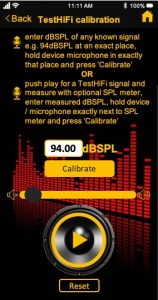
TestHiFi microphone calibration
TestHiFi microphone calibration is important, because TestHiFi measures the HiFi capability of a sound system by sending a complex test signal through the sound system and recording the signal played back by the sound system. The TestHiFi algorithm compares and analyzes the original test signal and its recorded playback.
TestHiFi measures various different criteria, like frequency range, distortions or stereo capability to assess quality of the sound played by the sound system. Many factors influence such measurements and make them complicated and complex. Room reflections, ambience noise, signal transfer implication and the microphone used for recording can be influencing factors to some extent.
Microphones in mobile phones are of appropriate high quality.
This is not at all a surprise, for the reason that it is the microphone that records the voice together with the ambience noise while you are talking on the phone. Therefore, over last decades engineers have significantly improved the speech quality. New inventions for the electronics and the microphones have mostly contributed to this improvement.
iPhone features several microphones.
As an example, the Apple iPhone 7 features a front-facing top microphone, two front-facing bottom microphones, and a rear-facing top microphone. All of them include significant technical innovations, like the dual backplane of Infineon Technologies used in the Goertek device. TestHiFi uses the front-facing bottom microphone and benefits from these most recent technological developments in microphones.
All microphones need calibration.
There are a lot of pretty complex microphone calibration technics around. Therefore, TestHiFi pre-calibrates the signal received by the microphone as a standard for all measurements. Operating systems of mobile phones provide TestHiFi with a built-in automatic calibration, which TestHiFi uses per default. The operating systems of mobile phones provide a function for decibel measuring. TestHiFi uses it and respectively pre-adjust for every measurement.
Have a microphone manually calibrated for best results.
To achieve most accurate test results, we recommend to manually calibrate the microphone. For this, TestHiFi provides the manual calibration function in the information menu. This function includes two options. One where you use an external signal with an exactly known dBSPL to set the calibration. Another one where you use an external dBSPL meter to measure the level of a signal sent by TestHiFi.
TestHiFi calibration options.

calibration – TestHiFi App
Use your own noise level for which you exactly know the dbSPL level. It can be a constant signal or a constant ambience noise. Further, enter the dbSPL level of your noise into the calibration dbSPL field and click the calibrate button. TestHiFi calibrates the measured noise at the time when you click the button to the level you have entered.
With the second option you send a TestHiFi calibration signal through any connected audio system. Pushing the play button on the calibration screen starts the signal. Further, after measuring the dBSPL of the TestHiFi signal at the audio system with an external dbSPL meter, you enter the dbSPL value into the field on the calibration screen. Make sure that the dBSPL of the TestHiFi signal is above the ambience dbSPL, i.e. it is louder. Then you hold the iPhone in the exact same position as the external dBSPL meter was when measured and push the calibrate button. Continue playing the TestHiFi calibration signal, during all these steps. TestHiFi calibrates the measured noise at the time when you click the button to the level you have entered.
Manual calibration sufficiently compensate hardware variations.
Production tolerances cause hardware differences of microphones in the mobile phones. This cannot be completely prevented. Hence, with your due care taken in this manual calibration process, you can sufficiently accurate measure with TestHiFi.